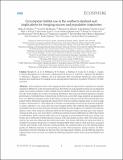Files in this item
Circumpolar habitat use in the southern elephant seal : implications for foraging success and population trajectories
Item metadata
| dc.contributor.author | Hindell, Mark A. | |
| dc.contributor.author | McMahon, Clive R. | |
| dc.contributor.author | Bester, Marthán N. | |
| dc.contributor.author | Boehme, Lars | |
| dc.contributor.author | Costa, Daniel | |
| dc.contributor.author | Fedak, Mike | |
| dc.contributor.author | Guinet, Christophe | |
| dc.contributor.author | Herraiz-Borreguero, Laura | |
| dc.contributor.author | Harcourt, Robert G. | |
| dc.contributor.author | Huckstadt, Luis | |
| dc.contributor.author | Kovacs, Kit M. | |
| dc.contributor.author | Lydersen, Christian | |
| dc.contributor.author | McInytre, Trevor | |
| dc.contributor.author | Muelbert, Monica | |
| dc.contributor.author | Roquet, Fabien | |
| dc.contributor.author | Williams, Guy | |
| dc.contributor.author | Charrassin, Jean-Benoit | |
| dc.date.accessioned | 2016-05-27T23:32:34Z | |
| dc.date.available | 2016-05-27T23:32:34Z | |
| dc.date.issued | 2016-05-26 | |
| dc.identifier | 209938332 | |
| dc.identifier | 19eb0bad-7ed1-448e-91d0-f2ef7dc729a6 | |
| dc.identifier | 84971634959 | |
| dc.identifier | 000377215200002 | |
| dc.identifier.citation | Hindell , M A , McMahon , C R , Bester , M N , Boehme , L , Costa , D , Fedak , M , Guinet , C , Herraiz-Borreguero , L , Harcourt , R G , Huckstadt , L , Kovacs , K M , Lydersen , C , McInytre , T , Muelbert , M , Roquet , F , Williams , G & Charrassin , J-B 2016 , ' Circumpolar habitat use in the southern elephant seal : implications for foraging success and population trajectories ' , Ecosphere , vol. 7 , no. 5 , e01213 . https://doi.org/10.1002/ecs2.1213 | en |
| dc.identifier.issn | 2150-8925 | |
| dc.identifier.other | ORCID: /0000-0002-9569-1128/work/47136262 | |
| dc.identifier.uri | https://hdl.handle.net/10023/8892 | |
| dc.description.abstract | In the Southern Ocean, wide-ranging predators offer the opportunity to quantify how animals respond to differences in the environment because their behavior and population trends are an integrated signal of prevailing conditions within multiple marine habitats. Southern elephant seals in particular, can provide useful insights due to their circumpolar distribution, their long and distant migrations and their performance of extended bouts of deep diving. Furthermore, across their range, elephant seal populations have very different population trends. In this study, we present a data set from the International Polar Year project; Marine Mammals Exploring the Oceans Pole to Pole for southern elephant seals, in which a large number of instruments (N = 287) deployed on animals, encompassing a broad circum-Antarctic geographic extent, collected in situ ocean data and at-sea foraging metrics that explicitly link foraging behavior and habitat structure in time and space. Broadly speaking, the seals foraged in two habitats, the relatively shallow waters of the Antarctic continental shelf and the Kerguelen Plateau and deep open water regions. Animals of both sexes were more likely to exhibit area-restricted search (ARS) behavior rather than transit in shelf habitats. While Antarctic shelf waters can be regarded as prime habitat for both sexes, female seals tend to move northwards with the advance of sea ice in the late autumn or early winter. The water masses used by the seals also influenced their behavioral mode, with female ARS behavior being most likely in modified Circumpolar Deepwater or northerly Modified Shelf Water, both of which tend to be associated with the outer reaches of the Antarctic Continental Shelf. The combined effects of (1) the differing habitat quality, (2) differing responses to encroaching ice as the winter progresses among colonies, (3) differing distances between breeding and haul-out sites and high quality habitats, and (4) differing long-term regional trends in sea ice extent can explain the differing population trends observed among elephant seal colonies. | |
| dc.format.extent | 27 | |
| dc.format.extent | 3864198 | |
| dc.language.iso | eng | |
| dc.relation.ispartof | Ecosphere | en |
| dc.subject | Foraging behaviour | en |
| dc.subject | Mirounga leonina | en |
| dc.subject | Physical oceanography | en |
| dc.subject | Population status | en |
| dc.subject | Sea ice | en |
| dc.subject | Southern Ocean water masses | en |
| dc.subject | QH301 Biology | en |
| dc.subject | GC Oceanography | en |
| dc.subject | BDC | en |
| dc.subject | SDG 14 - Life Below Water | en |
| dc.subject.lcc | QH301 | en |
| dc.subject.lcc | GC | en |
| dc.title | Circumpolar habitat use in the southern elephant seal : implications for foraging success and population trajectories | en |
| dc.type | Journal article | en |
| dc.contributor.sponsor | NERC | en |
| dc.contributor.sponsor | NERC | en |
| dc.contributor.institution | University of St Andrews. School of Biology | en |
| dc.contributor.institution | University of St Andrews. Sea Mammal Research Unit | en |
| dc.contributor.institution | University of St Andrews. Marine Alliance for Science & Technology Scotland | en |
| dc.contributor.institution | University of St Andrews. Scottish Oceans Institute | en |
| dc.identifier.doi | https://doi.org/10.1002/ecs2.1213 | |
| dc.description.status | Peer reviewed | en |
| dc.identifier.grantnumber | NE/E018289/1 | en |
| dc.identifier.grantnumber | en |
This item appears in the following Collection(s)
Items in the St Andrews Research Repository are protected by copyright, with all rights reserved, unless otherwise indicated.

